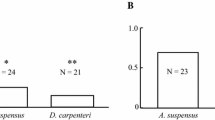Abstract
Phymastichus coffea (LaSalle) (Hymenoptera: Eulophidae) is an African endoparasitoid of the coffee berry borer, Hypothenemus hampei (Ferrari) (Coleoptera: Scolytidae) that has been introduced to several countries to control this important pest. In the present study we performed a series of laboratory experiments in order to determine if there was evidence of host discrimination and superparasitism in P. coffea. Our choice experiments demonstrate that P. coffea females showed significant preference to attack unparasitized hosts, rather than those parasitized conspecifically. No significant preferences were detected in self-specific attacks between parasitized hosts and the healthy ones. A further dissection of hosts sequentially attacked either self or conspecifically, revealed that there were no more than two eggs per host. As P. coffea is a species that normally allocates two eggs per host in a single attack, we assumed that females were able to attack already parasitized hosts, but they did not lay eggs in them. Based on this fact, we conclude that there is a host discrimination ability in P. coffea females. With respect to the superparasitism by P. coffea using non-choice experiments, there was no significant difference between self-specific or conspecific attacks with respect to the control after one or two successive attacks. Conspecific attacks yielded the largest numbers of eggs after 3rd, 4th and 5th attacks and significant differences were found between this treatment and the control. The maximum number of eggs found in a single host was six individuals (conspecific treatment). These results confirmed that P. coffea usually laid two eggs per host; however, when there are no hosts available, conspecific attacks can result in the superparasitism in this species.
Similar content being viewed by others
References
Bakker, K., J. J. M. van Alphen, F. H. D. van Batenburg, N. van der Hoeven, H. W. Nell, W. T. F. H. Van Liempt and T. C. Turlings, 1985. The function of host discrimination and superparasitization in parasitoids. Oecologia 67:572–576.
Borbon-Martý ´nez, O., 1989. Bioecologie d 'un ravageur des baies de cafeier, Hypothenemus hampei Ferr. (Coleo ´ptera;Scolytidae)et de ses parastioides au Togo. Doctoral Thesis. I 'Universite ´Paul Sabatier de Toulouse, France. 185 pp.
Espinoza, J. C., F. Infante, A. Castillo, J. F. Barrera, E. Pinson and V. H. Galindo, 2002. —Biologý ´a en campo de Phymastichus coffea (Hymenoptera:Eulophidae), un parasitoide de adultos de la broca del cafe ´. In:XXV Congreso Nacional de Control Biolo ´gico. Hermosillo, Sonora, Me ´xico. pp. 23–25.
Feldhege, M. R., 1992. Rearing techniques and aspects of biology of Phymastichus coffea (Hymenoptera:Eulophidae), a recently described endoparasitoid of the coffee berry borer, Hypothenemus hampei (Coleoptera:Scolytidae). Cafe ´, Cacao, The ´31:45–54.
Godfray, H. C. J. 1994. Oviposition behavior. In:H. C. J. Godfray (ed), Parasitoids. Behavioral and Evolutionary Ecology. Princeton University Press, pp. 83–150.
Infante, F., S. T. Murphy, J. F. Barrera, J. Go ´mez, W. de la Rosa and A. Damon, 1994. —Crý ´ade Phymastichus coffea parasitoide de la broca del cafe ´, y algunas notas sobre su historia de vida. Southwestern Entomologist 19:313–315.
Labeyrie, V. and D. Rojas-Rousse, 1987. Why intraspecific competition is not neces-sarily noxious?In:INRA (ed), Parasitoid Insects. Les Colloques de l 'INRA, Paris. 48:143–149.
LaSalle, J., 1990. A new genus and species of Tetrastichinae (Hymenoptera:Eulophi-dae)parasitic on the coffee berry borer, Hypothenemus hampei (Ferrari)(Coleoptera: Scolytidae). Bull. Entomol. Res. 80:7–10.
Le Pelley, R. H., 1968. Pests of coffee. Longmans Green and Co., London. 590 pp.
Lo ´pez-Vaamonde, C. and D. Moore, 1998. Developing methods for testing host spec-ificity of Phymastichus coffea LaSalle (Hym.:Tetrastichinae), a potential biological control agent of Hypothenemus hampei (Ferrarri)(Col.:Scolytidae)in Colombia. Biocontrol Sci. Technol. 8:397–411.
Nufio, C. R. and D. R. Papaj, 2001. Host marking behavior in phytophagous insects and parasitoids. Entomol. Experiment. Appl. 99:273–293.
Outreman, Y., A. Le Ralec, M. Plantegenest, B. Chaubet and J. S. Pierre, 2001. Superparasitism limitation in an aphid parasitoid:cornicle secretion avoidance and host discrimination ability. J. Insect Physiol. 47:339–348.
Van Alphen, J. M. and M. E. Visser, 1990. Superparasitism as an adaptive strategy for insect parasitoids. Annu. Rev. Entomol. 35:59–79.
Van Lenteren, J. C. 1981. Host discrimination by parasitoids. In:D. A., Nordlund, R. L. Jones and W. J. Lewis (eds), Semiochemicals, their Role in Pest Control. Wiley, New York. pp. 153–179.
Vergara O., J. D., J. Orozco, A. E. Bustillo and C. Chaves, 2001. —Biologý ´ade Phymastichus coffea en condiciones de campo. Cenicafe 52:97–103.
Visser, M. E., B. Luyckx, H. W. Nell and G. J. F. Boskamp, 1992. Adaptive superparasitism in solitary parasitoids:marking of parasitized hosts in relation to pay-off fromsuperparasitism. Ecol. Entomol. 17:76–82.
Author information
Authors and Affiliations
Rights and permissions
About this article
Cite this article
Castillo, A., Infante, F., Vera-Graziano, J. et al. Host-discrimination by Phymastichus coffea, a parasitoid of the coffee berry borer. BioControl 49, 655–663 (2004). https://doi.org/10.1007/s10526-004-5277-0
Issue Date:
DOI: https://doi.org/10.1007/s10526-004-5277-0




